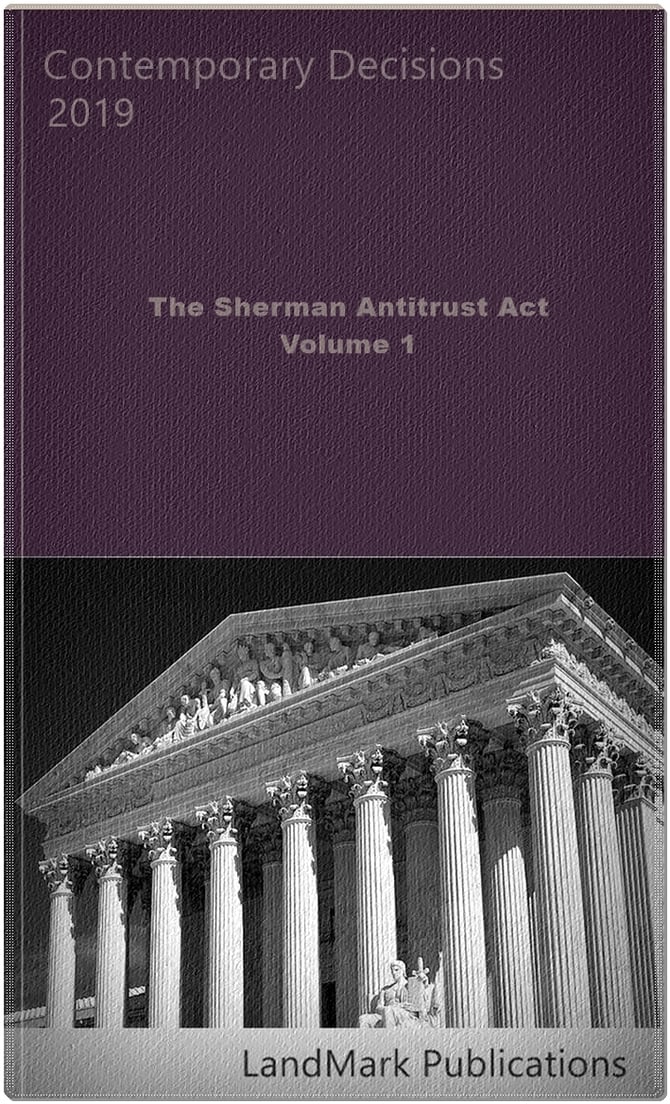
The Sherman Antitrust Act 2019, Volume 1
Purchasers have access to all three of the following file formats:
pdf
epub
mobi
THIS CASEBOOK contains a selection of U. S. Court of Appeals decisions that analyze, interpret and apply provisions of the Sherman Antitrust Act. Volume 1 of the casebook covers the District of Columbia Circuit and the First through the Fifth Circuit Court of Appeals.
For an arrangement to be a conspiracy under § 1, it "must embody concerted action." Am. Needle, 560 U.S. at 191, 130 S.Ct. 2201. Concerted action exists where there is an agreement between "separate economic actors pursuing separate economic interests." Id. at 195, 130 S.Ct. 2201 (internal quotation marks omitted). The fact that the co-conspirators are capable, due to their separateness, of acting in concert is not sufficient. Proof of a conspiracy is required. Capital Imaging Assocs., P.C. v. Mohawk Valley Med. Assocs., Inc., 996 F.2d 537, 545 (2d Cir. 1993).
A plaintiff must offer "direct or circumstantial evidence that reasonably tends to prove ... a conscious commitment to a common scheme designed to achieve an unlawful objective." Monsanto Co. v. Spray-Rite Serv. Corp., 465 U.S. 752, 768, 104 S.Ct. 1464, 79 L.Ed.2d 775 (1984). Rarely do co-conspirators plainly state their purpose. As a result, courts often must evaluate circumstantial evidence of a conspiracy by weighing "plus factors, which, when viewed in conjunction with the parallel acts, can serve to allow a fact-finder to infer a conspiracy." United States v. Apple, Inc., 791 F.3d 290, 315 (2d Cir. 2015) (citation and internal quotation marks omitted). In Monsanto, the Supreme Court noted that courts should look for evidence that "tends to exclude the possibility that the [defendant was] acting independently." Monsanto, 465 U.S. at 764, 104 S.Ct. 1464. In Matsushita, the Supreme Court elaborated on what this meant: "[C]onduct as consistent with permissible competition as with illegal conspiracy does not, standing alone, support an inference of antitrust conspiracy." Matsushita Elec. Indus. Co. v. Zenith Radio Corp., 475 U.S. 574, 588, 106 S.Ct. 1348, 89 L.Ed.2d 538 (1986).
* * *
Only unreasonable restraints on competition violate § 1 of the Sherman Act. Courts use one of two tests here. "[A] restraint may be adjudged unreasonable either because it fits within a class of restraints that has been held to be 'per se' unreasonable, or because it violates what has come to be known as the 'Rule of Reason.'" Ind. Fed'n of Dentists, 476 U.S. at 457-58, 106 S.Ct. 2009. Regulation of league sports is a textbook example of when the rule of reason applies. See Nat'l Collegiate Athletic Ass'n v. Bd. of Regents of Univ. of Okla., 468 U.S. 85, 101, 104 S.Ct. 2948, 82 L.Ed.2d 70 (1984).
North Amer. Soccer League v. US Soccer Feder., 883 F. 3d 32 (2nd Cir. 2018)

